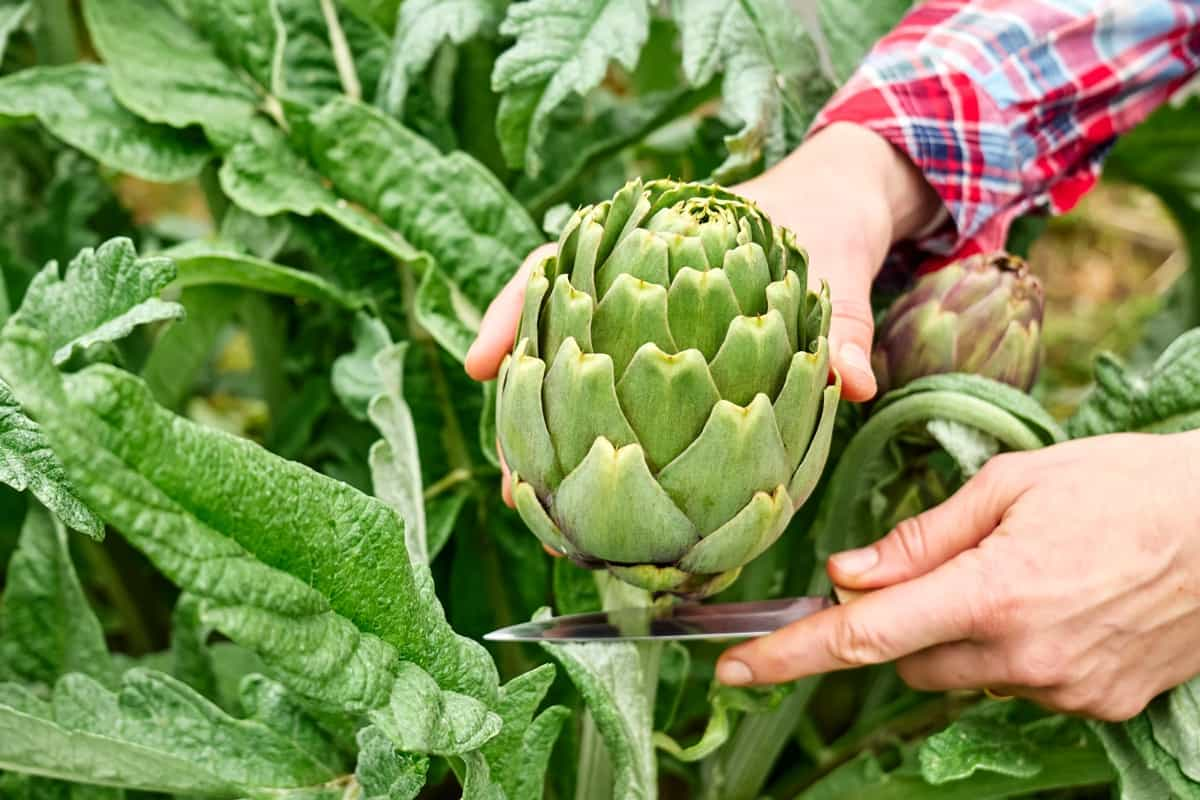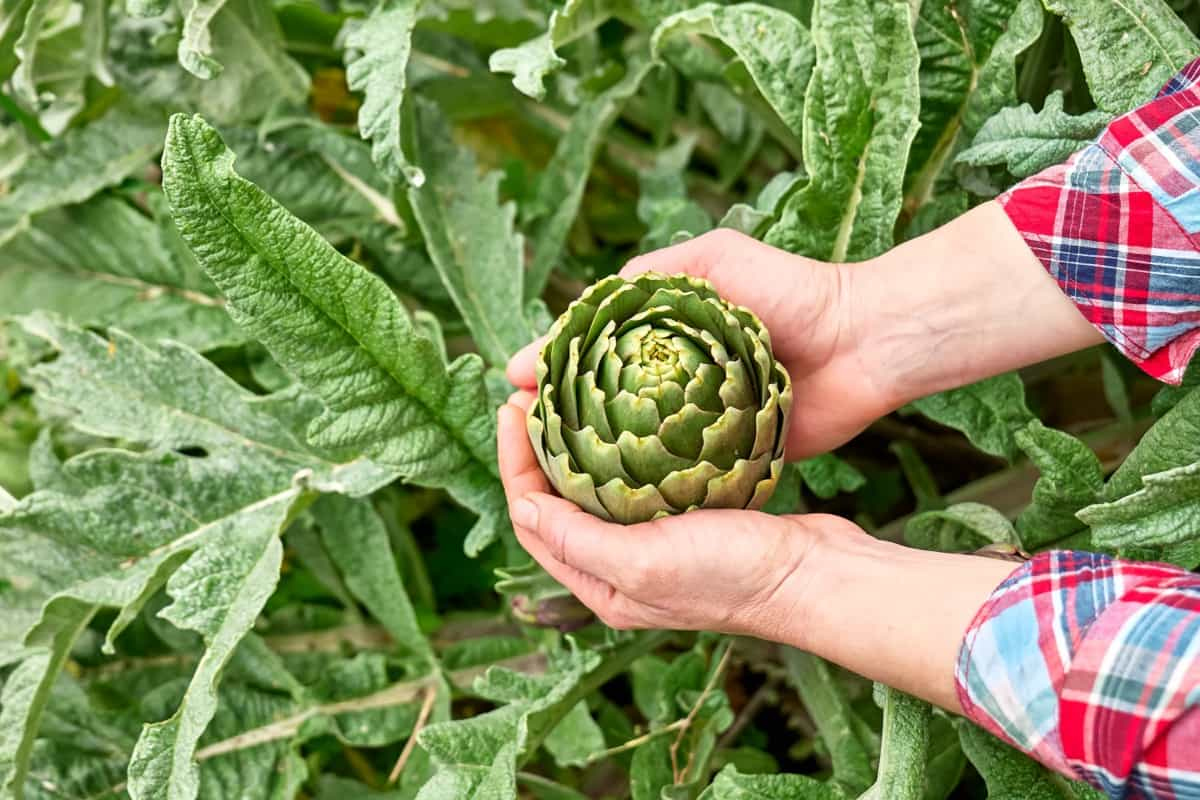Artichoke plants are a rewarding addition to any garden, providing striking visual appeal and a delicious, healthy harvest. However, growing artichokes isn’t always a walk in the park, with various challenges that can plague these plants. Here, we’ll delve into the top ten issues that artichoke plants commonly face, offering valuable insights into identification, treatment, and prevention, including artichoke supplement side effects and the appropriate use of pesticides.

10 Common Problems With Artichoke Plants
How to Prevent Aphids on Artichoke Plants Naturally
The first common problem that affects artichoke plants is aphids. These small, soft-bodied insects feed on the plant’s sap, causing the leaves to curl and the plant’s overall health to deteriorate. Preventing aphid infestation can be as simple as encouraging the presence of their natural predators in your garden. Ladybugs, lacewings, and certain species of birds all feast on aphids.
Introducing these beneficial creatures and plants that attract them can keep aphids in check. Regular inspection and pruning of your plants can also help prevent an infestation. If an aphid problem persists, consider using a safe, organic pesticide. Choose a pesticide designed for vegetables to ensure it won’t adversely affect the plant or its edibility.
Dealing With Artichoke Bud Drop: Causes and Solutions
Artichoke bud drop is another prevalent issue, causing the immature buds to drop off the plant before they have a chance to fully develop. The leading causes of bud drop include insufficient sunlight, poor soil, and inconsistent watering practices. Ensure your artichokes get full sun exposure and consistent, deep watering to combat this. Amend your soil with organic compost to improve its quality and nutrient content. Ensuring your plant has adequate levels of boron can also help prevent bud drop, as boron aids in the plant’s reproduction process.
Controlling Fungal Diseases in Artichoke Plants
Artichokes can also suffer from various fungal diseases, resulting in yellowed leaves, stunted growth, and reduced yields. To control these fungal issues, ensure that your artichokes are spaced correctly, allowing for proper air circulation. Consider crop rotation, which helps prevent the build-up of disease-causing fungi in the soil. Additionally, using a fungicide can help control the spread of fungal diseases. However, be careful when choosing a fungicide. Some can have side effects similar to those seen with artichoke supplements, such as stomach upset and diarrhea.
Identifying and Treating Artichoke Crown Rot
Artichoke crown rot is a destructive disease that can cause wilting, yellowing leaves, and even plant death. Early detection is key to managing this issue. If you notice a soft, brown rot at the base of the plant, crown rot may be the culprit. To treat this problem, remove and discard the affected plants and avoid planting artichokes in that area for a few years. Improving soil drainage and avoiding overwatering can help prevent crown rot in the future.
Managing Nutrient Deficiencies in Artichoke Plants
Artichokes are heavy feeders, which can lead to nutrient deficiencies if improper fertilizers them. Yellow or pale green leaves, slow growth, and reduced yield can all be signs of nutrient deficiencies. A well-balanced organic fertilizer can help give your artichokes the nutrients they need to thrive. Ensure the fertilizer contains adequate nitrogen, phosphorous, and potassium levels, which are essential for plant growth. Additionally, regularly test your soil to determine if any specific nutrient deficiencies must be addressed.
In case you missed it: How to Grow Artichoke in a Greenhouse: A Step-By-Step Guide for Seed to Harvest

Preventing Artichoke Heart Rot in the Garden
Artichoke heart rot is a potentially devastating condition that can cause the heart of the artichoke to rot while still on the plant. The main cause of heart rot is typically an infestation of insects like aphids or thrips, which introduce bacteria into the plant. Regularly inspect your plants for signs of insects and use an appropriate pesticide to control infestations. As discussed earlier, consider a vegetable-specific pesticide to avoid possible side effects on the plant or the produce.
Dealing With Artichoke Leaf Miners: Natural Remedies
Artichoke leaf miners are small insects that tunnel through the leaves of the artichoke, causing significant damage and reducing the plant’s ability to photosynthesize. Natural remedies for leaf miners include introducing beneficial insects like parasitic wasps that prey on leaf miners. Keeping your garden clean and free from plant debris can also help reduce the leaf-miner population. In severe cases, a carefully selected pesticide may be necessary.
Overcoming Artichoke Plant Wilting and Drooping Leaves
Wilting and drooping leaves in artichoke plants can indicate several problems, including overwatering, underwatering, or a pest infestation. Ensuring your artichokes are watered correctly is essential, as too much and too little water can lead to wilting. Make sure to regularly observe your plants to detect any indications of pests and take immediate action to deal with any infestations that may arise. If the problem persists, your plant might be suffering from a disease, in which case the infected plants should be removed to prevent the spread of the disease.
Identifying and Treating Artichoke Pests: Slugs and Snails
Slugs and snails are common pests that enjoy feasting on artichoke leaves. Damage from these pests can lead to reduced plant vigor and yield. Identifying a slug or snail problem is relatively easy; look for the distinct trail they leave behind and the large, irregular holes in the leaves. To control these pests, consider using slug and snail baits or traps. Alternatively, certain plants like lavender and rosemary are known to repel slugs and snails and can be planted around your artichokes as natural pest control.
| Pest | Description | Prevention | Treatment |
| Slugs | Soft-bodied mollusks that eat plant leaves. | Use slug baits or traps, and introduce natural predators like birds or beetles. | Handpick and remove; use a slug-specific pesticide if necessary. |
| Snails | Hard-shelled mollusks that feed on plant leaves. | Plant snail-repelling plants like lavender or rosemary use snail traps. | Remove by hand; use a snail-specific pesticide if needed. |
Managing Artichoke Plant Overgrowth and Overcrowding
Overgrowth and overcrowding can become a significant issues in your artichoke garden. Overgrown plants can shade out others, resulting in unequal growth and potentially encouraging the spread of diseases and pests. Overcrowded plants can compete for nutrients, water, and sunlight, leading to poor overall health. Regular pruning and correct plant spacing are essential to prevent overgrowth and overcrowding. You’ll promote healthier, more vigorous artichokes by trimming excessive growth and ensuring your plants have enough space to grow.
In case you missed it: Frequently Asked Questions About Growing Artichoke from Seed to Harvest

Conclusion
While growing artichokes can come with unique challenges, the reward of a homegrown, healthy harvest is well worth the effort. Armed with this knowledge, you’re now equipped to tackle the most common problems you may face with your artichoke plants, ensuring they remain healthy, vibrant, and productive.
- Ultimate Guide to Ossabaw Island Hog: Breeding, Raising, Diet, and Care
- Ultimate Guide to Juliana Pig: Raising Facts, Size, Diet, Care, and Lifespan
- Raising Lleyn Sheep: Disadvantages, Price, Uses, Characteristics, and Care
- Ultimate Guide to Meishan Pig: Breed Facts, Breeding, Raising, and Care
- Ultimate Guide to Teacup Pigs: Raising, Diet, Lifespan, Cost, and Care
- Guide to Raising Poll Dorset Sheep: Facts, Profile, Characteristics, Uses, and Care
- Ultimate Guide to Bighorn Sheep: Characteristics, Diet, Lifespan, Breeding, and Lifecycle
- Ultimate Guide to Raising Katahdin Sheep: Farming Facts, Breed Profile, Uses, and Care
- Ultimate Guide to Raising Oreo Cows: Belted Galloways Farming Facts, Profile, Uses, and Care